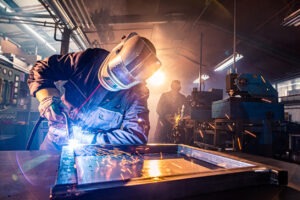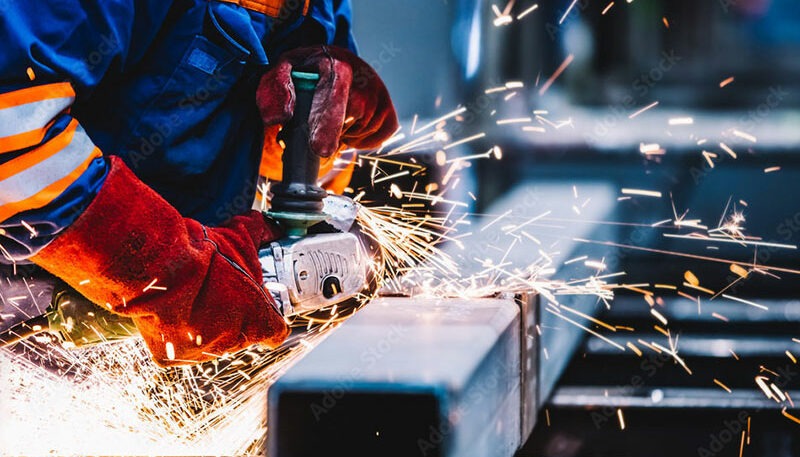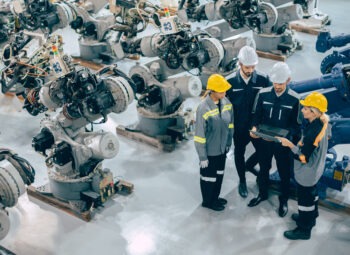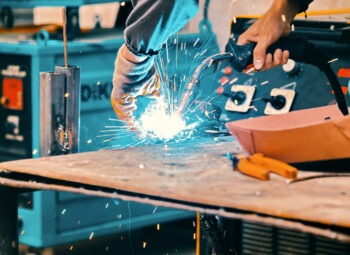While welding has become an integral part of everyday life in many jobs today, it first had to have a beginning in history and then go through various stages of development. Only in this way, with trial and error, did it become what we know today.
Welding as a process of joining workpieces is really nothing new. Today, we think of the automotive industry, shipbuilding and mechanical engineering when it comes to welding. None of this existed in the past, but even then things had to be joined and the joint had to be of good quality and, above all, very durable.
Finds from the tombs of the Sumerians prove that materials were already being joined using welding techniques at this time. Of course, welding was not as well developed as it is today. It can rather be seen as a hard soldering of gold, silver and copper. This makes soldering one of the oldest known thermal joining processes. Brazing was followed by fire welding, which was used to make weapons, tools, artefacts and other items. This technique was used 3,000 years ago and is the actual precursor to what we know today as manual welding.
Fire welding
The word "welding" is also very likely to be traced back to the process of fire welding. Welding comes from sweat, from sweating. Fire welding was carried out in a forge fire and the surface of the workpieces "sweated", which then created the joint. In fact, fire welding was to remain the only welding method for a very long time. It was only when oxygen and fuel gases could be used to generate flames with a much higher energy that new welding methods were developed. Whilst a little heat and a lot of pressure were used for flame welding, the hotter flames of the new welding could do without the pressure. Gas welding was thus born as a first form of fusion welding and was used for the first time in 1840.
Flame cutting
Flame cutting emerged between 1901 and 1905 and also established itself as an important process. Arc and resistance welding followed in the 1940s. Gas-shielded welding became established for non-ferrous metals.
Added to this was the TIG welding in 1946, which developed from carbon arc welding. In 1948, MIG welding was introduced and MAG gas-shielded welding is still one of the most widely used welding processes today.
Welding has thus existed for several millennia, with the Sumerians and Hittites making the start in the 3rd millennium BC. However, its rapid development into what we know today only began in the 19th century, when general progress led to the development of new welding processes.Fire and hammer welding
Fire and hammer welding
Fire and hammer welding began around 1,500 years before Christ. It can be traced back to this time in Asia Minor and was used to join metallic materials. Only thanks to fire welding was it possible to produce tools, agricultural equipment, weapons and grilles in forges from the beginning of the Iron Age until the 19th century.
Over the many years, fire welding became a component of very complicated processes, which also included forging the sponge iron, colouring, i.e. cleaning the iron, and folding the iron several times. These steps were then followed by hot-dip welding.
Gas fusion welding
Acetylene was discovered by Edmund Davy in 1836. In addition, Carl von Linde developed a method of air liquefaction in 1895. Both made it possible to produce very high-energy flames. This in turn advanced welding by making fusion welding possible.
With a flame fuelled by acetylene and oxygen, temperatures of more than 3,000 °C could be reached. This was 500 °C hotter than was possible with a flame made from a mixture of oxygen and hydrogen. This paved the way for gas welding, which marked the beginning of gas fusion welding, even if it was initially still referred to as oxyfuel welding.
Subsequently, Chemische Fabrik Griesheim-Elektron and Drägerwerk Lübeck, Heinr. & Berh. Dräger, further developed the technology of gas fusion welding. This led to the development of the illuminating gas torch for welding and cutting in 1896, followed by the Dräger oxyhydrogen welding torch in 1900 and 1901. In co-operation with Ernst Wiss from Chemische Fabrik Griesheim-Elektron, a working group was founded which subsequently further developed welding and cutting techniques.
Arc welding
A further advance made the emergence of arc welding or electric welding possible. This consisted of the discovery of an electric arc and the start of the industrial generation of electricity. This made it possible to use this electricity and the arc it generated for fusion welding.
It was Nikolai Nikolayevich Benardos and Stanislaw Olszewski who used the electric arc for fusion welding for the first time. They used two carbon electrodes with which the corresponding temperatures for the arc could be generated.
Nikolai Gavrilovich Slavyanov subsequently developed the process further. In 1891, he began to replace the carbon electrodes with a metal rod. This was not only the arc carrier, it also served as a welding filler. However, the rod electrodes that were created in this way were not coated at the beginning. This meant that it was not easy to protect the welding point from the air and the associated oxidation. This still made this form of welding a bit of a challenge in the beginning.
This was remedied in 1907 by Oscar Kjellberg. He had the idea of improving the properties of the arc by coating the metallic rod electrodes. This also meant that the weld pool was protected from atmospheric oxygen.
This led to the development of various coatings for welding with electrodes that also corresponded to the metallurgical properties of the material. This led to manual arc welding using coated stick electrodes becoming the standard welding process.

TIG welding
With all the welding that was developed at the time, there was still a big problem. Nobody could weld magnesium with it, because this metal was highly flammable. It remained so even when it was in an alloy. Russel Meredith from Northrop Aircraft therefore tried to develop a process that prevented the magnesium from igniting.
For his welding process, he used an electrode made of tungsten and helium as the TIG shielding gas. Meredith called it Heliarc, but TIG welding, from tungsten inert gas welding, became the established name.
Over the years, many improvements have been made to TIG welding. These included cooling with water and the use of shielding gas nozzles. The composition of the electrodes and the power sources were also improved. The latter in particular led to the welding voltage being superimposed with a high-frequency voltage. This also made it possible to weld aluminium using alternating current.
Gas metal arc welding
In 1935, an important patent was registered in Great Britain under the name "Improvements in Electric Arc Welding". A feed motor was used to operate a coil that evenly fed a wire electrode.
Perry J. Rieppel built his patent on this, which he registered in the USA in 1948. He combined arc welding with the electric coil and electrode tracking with a shielding gas. Inert gases such as argon and helium were used. This is why it is also referred to as argon welding or helium welding.
Rieppel himself used "Shielded Arc Welding" as the name for his process. This then became the term SIGMA welding, for "Shielded inert gas metal arc", as long as inert gases were used.
In the beginning, no active gases could be used. These had a toxic effect. CO was also flammable and elements in the alloys of the materials burned off.
In the Soviet Union, engineers N.M. Novozhilov and K.V. Liubavskii worked on this problem using CO2 as protection. This led them to develop special wires in the 1950s whose properties equalised the burn-off. This made CO2 or MAG welding, metal active gas welding, possible, which now allowed for a corresponding quality of weld seams.
Gas metal arc welding was subsequently developed further. For example, controlled current sources made it possible to control the deposition process in a targeted manner. Current pulses controlled the material transfer. This made it possible to reduce the heat input into the materials when welding with shielding gas and to increase the deposition rate, which improved productivity.
Impulse welding
MIG/MAG welding leads to an uneven material transfer when a short arc is used. Pulse welding was introduced so that the detachment of the droplets of molten material can be specifically controlled. Here, current pulses are used in which one droplet is detached at a time due to the increase in current.
Initially, two power sources were used for this process. However, with the advent of controllable power sources, a single such source was able to take over the entire task.
Here, too, development did not stand still. In Austria, for example, CMT welding (cold metal transfer) was developed for operational readiness in 2005. In this process, the welding current is pulsed and the filler wire is moved forwards and backwards while maintaining a high frequency. This makes it possible to ensure targeted droplet detachment. At the same time, the energy requirement is reduced and the heat input into the material is minimised.
The ColdArc process was also developed in 2005. Here, too, the aim is to minimise heat input. Here, all process interventions come from the power source. A constant wire feed is used for this purpose. Ordinary welding torches can be used for this.
T.I.M.E. welding
T.I.M.E. welding, which stands for "Transferred ionised molten energy", is used to increase the overall deposition rate. It utilises gas-shielded welding with a consumable wire as the basis. Consistent quality is ensured with special gas mixtures, while productivity increases thanks to higher deposition rates.
Resistance welding
Resistance welding was first mentioned in 1766. An attempt was made to weld flint balls using a capacitor discharge. This was followed in 1782 by the welding of a watch spring to a knife blade using so-called artificial electricity.
It was not until 1857 that resistance welding was used again, which was demonstrated by James Prescott Joule as a joining process. This led to the work of Elihu Thomson, who began his work in 1877 and applied for two patents in 1886, which centred on the butt welding of metal wires.
Henry F.A. Kleinschmidt then helped resistance welding achieve a breakthrough in 1897 with the help of copper electrodes. He also came up with the idea of using welding projections for resistance welding to weld fishplates on rails. This led to the development of the resistance projection and roller seam welding method in 1910. As a result, resistance welding was widely used in industry from 1930 onwards.
Narrow gap welding
Narrow-gap welding is used to weld particularly thick sheets. These normally require extensive and therefore complex seam preparation. A V-joint is created, which enables the entire edge to be welded.
Although seam preparation is still necessary for the narrow-gap technique, this can be significantly reduced. This is because a pronounced V is no longer required. The flanks can lie almost parallel to each other. This means that sheets with a thickness of up to 300 mm can be welded.
The greatly reduced opening angle in this way not only reduces the preparation of the seam. It also saves on filler materials and the amount of shielding gas required. It also means that fewer welding beads are required. This in turn reduces the time required for the welding process.
As a result, the component heats up less, which also reduces distortion. A rotating contact tube makes it possible to set oscillating welding positions or line beads. The narrow-gap blade is used to guide the arc sensor in the centre of the joint. Water is cooled right up to the gas nozzle. This makes it possible to weld continuously for several hours.
Arc stud welding
The work that led to arc stud welding began as early as 1915 with Harold Martin in the UK. He applied for a patent in 1920, according to which an electric arc is generated between a stud and a metal plate. The arc is held for a certain amount of time, which can be adjusted. At the end, the bolt is then immersed in the molten bath by an electrical, mechanical or pneumatic force.
Then, in the 1940s, Ted Nelson worked on simplifying bolted joints that fastened wooden planks directly to steel plates. Until then, fillet welding had been used for this. He replaced this with a threaded bolt that was melted with an electric arc. The welding device then immersed it in the molten pool. Using a chuck and electromagnets, the stud was lifted and held so that a constant arc length was created. The welding time was set using a timer.
The magnetically moved arc
In the USA, J.W. Dawson applied for a patent in 1942 which described butt welding with a rotating arc as the heat source in a radial magnetic field. This process was widely used in the 1950s and 1960s, particularly in the Soviet Union. It was then also used in Germany in the 1970s. However, the rotating arc was replaced as the heat source for butt welding by a ring-shaped auxiliary electrode and referred to as MBP welding.
Conclusion
Welding began as brazed joints among the Sumerians and Hittites. This was followed by fire welding, which was the only method of producing tools, artefacts and weapons from metal for thousands of years.
Then, with the rapid industrial development in the 19th century, newer and more sophisticated welding processes became more widely used. This has continued right up to the developments of today.






